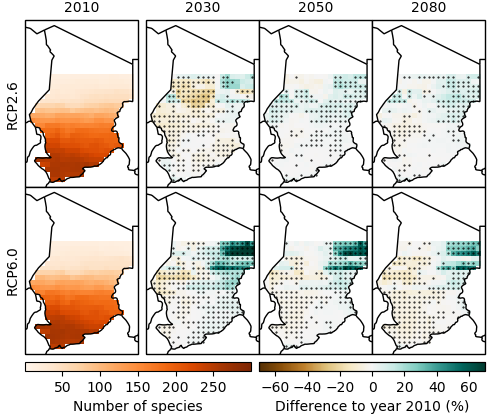Chad: Ecosystems
Climate change is expected to have a significant influence on the ecology and distribution of tropical ecosystems, though the magnitude, rate and direction of these changes are uncertain [34]. With rising temperatures and increased frequency and intensity of droughts, wetlands and riverine systems are increasingly at risk of being converted to other ecosystems with plants being succeeded and animals losing habitats. Increased temperatures and droughts can also influence succession in forest systems while concurrently increasing the risk of invasive species, all of which affect ecosystems.
Species richness

Model projections of species richness (including amphibians, birds and mammals) and tree cover for Chad are shown in Figure 15 and 16, respectively. The models applied for this analysis show similar patterns of change in species richness across both RCPs, with higher modelling uncertainty under RCP2.6. Under RCP6.0, models project increases in the number of species of up to 40 % for north-eastern Chad and decreases of up to 20 % for the western and southern parts of the country by 2080.
Tree cover

With regards to tree cover, model projections vary depending on the scenario (Figure 16). Under RCP2.6, models project a decrease in tree cover of 2 % for the very south of Chad, while under RCP6.0, tree cover is projected to increase by 2 % in the south of the country by 20807.
Although these results paint a rather positive picture for climate change impacts on tree cover, it is important to keep in mind that the model projections exclude any impacts on biodiversity loss from human activities such as land use, which have been responsible for significant losses of global biodiversity in the past, and are expected to remain its main driver in the future [35]. For example, population influxes in affected areas, need for pasture and agricultural land and logging have resulted in high rates of deforestation [36]: Chad has lost 1.54 million ha of forest cover in the period from 2001 to 2016, which is equivalent to a 25 % decrease [37].
7 Due to the low starting values of tree cover in most parts of Chad, even small actual changes can lead to high percentage changes, which is why tree cover projections should be considered with caution.
References
[34] T. M. Shanahan et al., “CO² and Fire Influence Tropical Ecosystem Stability in Response to Climate Change,” Nat. Publ. Gr., no. July, pp. 1–8, 2016.
[35] IPBES, “Report of the Plenary of the Intergovernmental Science-Policy Platform on Biodiversity and Ecosystem Services on the Work of Its Seventh Session,” n.p., 2019.
[36] FAO and UNHCR, “Rapid Woodfuel Assessment 2017 Baseline for the Area Around the City of Goré, Chad,” Rome, Italy and Geneva, Switzerland, 2018.
[37] Global Forest Watch, “Chad.” Online available: https://www.globalforestwatch.org [Accessed: 27-Apr-2020].


